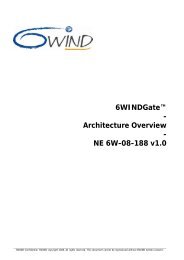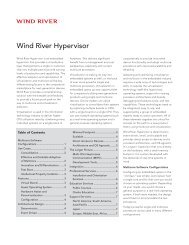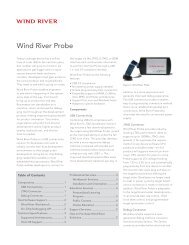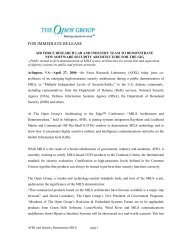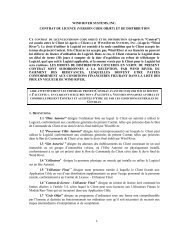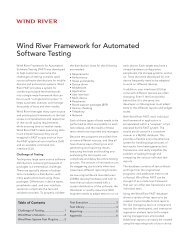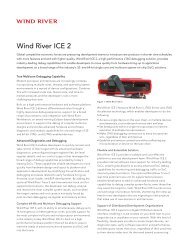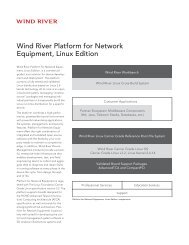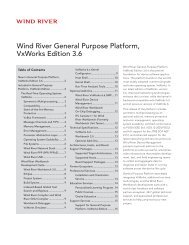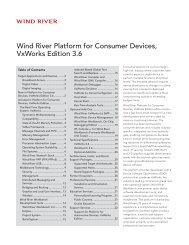ConfD - Wind River
ConfD - Wind River
ConfD - Wind River
You also want an ePaper? Increase the reach of your titles
YUMPU automatically turns print PDFs into web optimized ePapers that Google loves.
Next-Generation Configuration<br />
Management<br />
The increasing complexity of operator and<br />
enterprise networks and the requirement<br />
to deliver new services is driving the need<br />
for improved configuration management<br />
systems. Network operators can no longer<br />
afford to manually provision their networks.<br />
Automated configuration management is<br />
needed to reduce costs, increase reliability,<br />
and respond to customer demands.<br />
<strong>ConfD</strong> provides the industry-leading<br />
implementation of NETCONF to ensure that<br />
configuration changes are uniformly rolled<br />
out and as a result networking solutions are<br />
truly scalable. The NETCONF standard is<br />
now supported by many leading suppliers<br />
of networking equipment and is becoming<br />
a requirement for users of large networks.<br />
Carrier and Enterprise-Class<br />
Implementations<br />
<strong>ConfD</strong> is designed to meet the performance,<br />
scalability, redundancy, and security needs<br />
of carrier and enterprise-class network management<br />
systems. Such capabilities include:<br />
• Transaction management<br />
• Session management<br />
• Audit trailing<br />
• Role-based access control<br />
• Authentication over RADIUS and LDAP<br />
• Extensible schema validation<br />
• Rollback management<br />
• Replication and High-Availability<br />
High performance and scalability are crucial<br />
in large systems. <strong>ConfD</strong> uses its own parsing<br />
algorithm that streams XML data to ensure<br />
that memory usage is bounded. Its embedded<br />
database is optimized to allow very<br />
efficient operations on binary encoded XML<br />
data structures.<br />
Faster and More Affordable<br />
Development<br />
<strong>ConfD</strong> radically reduces the time and resources<br />
needed to develop network management<br />
applications, helping developers to meet<br />
critical market deadlines.<br />
<strong>ConfD</strong> allows developers to describe a data<br />
model for their system once and then, using<br />
a unique technology, to automatically render<br />
CLI, Web, SNMP, and NETCONF interfaces.<br />
Tail-f Systems provides extensive ready to<br />
use libraries of XML specifications and C<br />
instrumentation code for many of the features<br />
expected in a networking device.<br />
In addition to speeding time-to-market, <strong>ConfD</strong><br />
reduces the cost and time involved in maintaining<br />
and supporting applications. <strong>ConfD</strong> allows<br />
NETCONF, CLI, Web, and SNMP interfaces to<br />
use a single set of core functionality, including<br />
a configuration database, and share one set of<br />
common instrumentation functions, thereby<br />
avoiding the tedious recoding efforts required<br />
by legacy stovepipe architectures.<br />
In the “Stove Pipe” approach, management<br />
interfaces connect directly to the Managed<br />
Objects (MOs). The Tail-f approach separates the<br />
management interfaces and back-end system.




